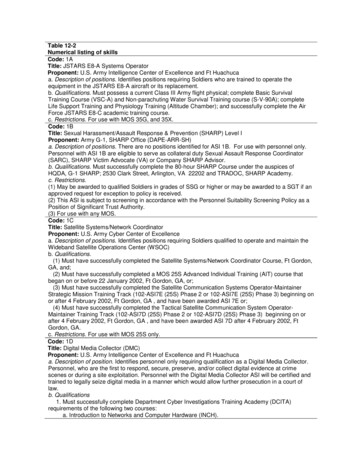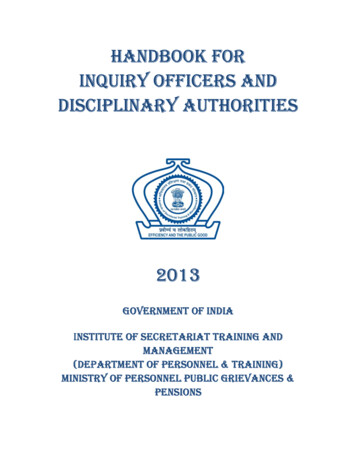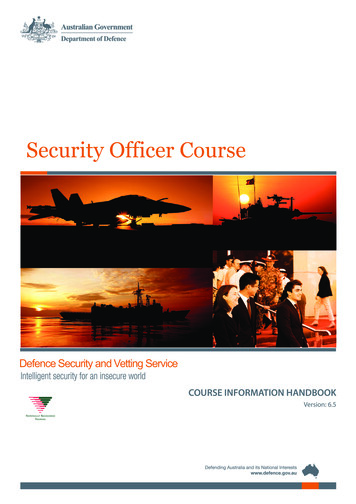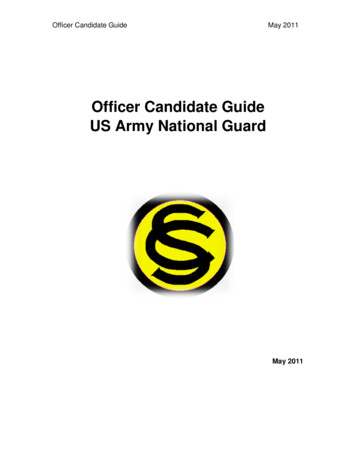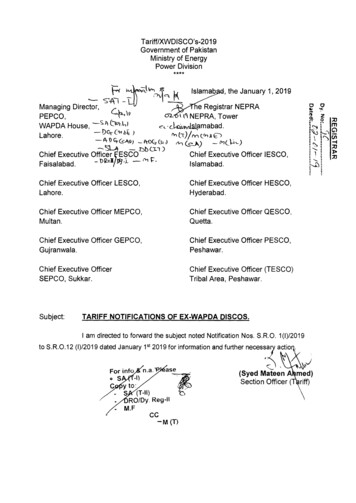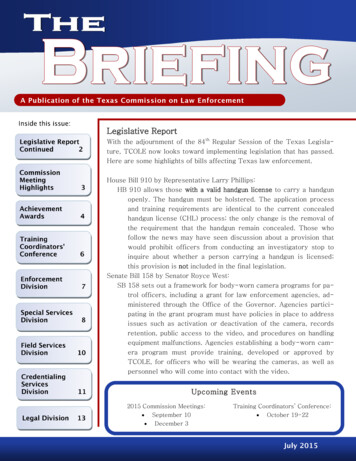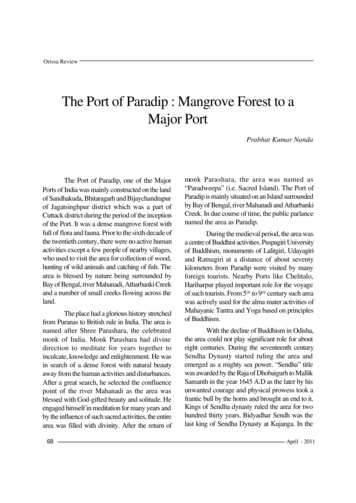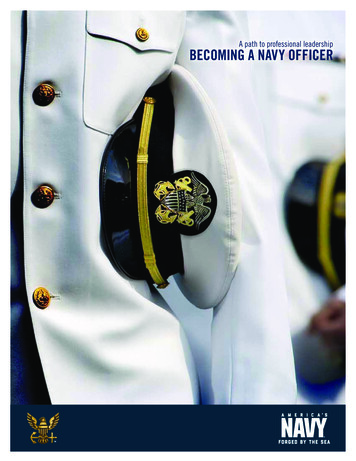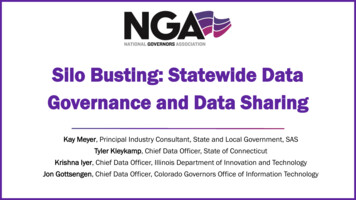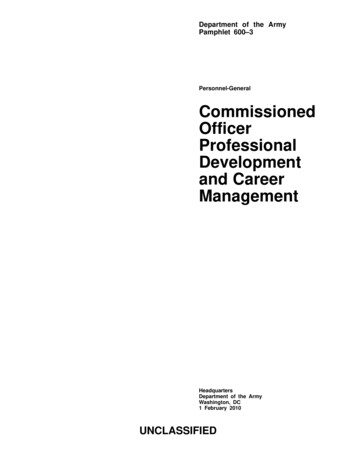
Transcription
Department of the ArmyPamphlet ionalDevelopmentand CareerManagementHeadquartersDepartment of the ArmyWashington, DC1 February 2010UNCLASSIFIED
SUMMARY of CHANGEDA PAM 600–3Commissioned Officer Professional Development and Career ManagementThis major revision, dated 1 February 2010-oIncorporates desired officer characteristics, under the Officer PersonnelManagement System, from Army Field Manual 3.0 Operations. Adds officerbroadening concepts at the grades of major and above. Incorporates JointOfficer Qualification System information (chap 3).oAdds information on the evolution of the Officer Education System toincorporate agile and adaptive leader educational paths (chap 4).oIncorporates extensive details on Reserve Component development, education,and utilization of officers (chap 7).oUpdates the human resources area of concentration to reflect a consolidationof services under the Adjutant General Branch (chap 36).oConsolidates functions and officer development for the Finance Corps Branchand the Comptroller functional area into a single Financial Management Branch(chaps 37 and 38).oAdds a chapter on the electronic warfare officer, to reflect a new functionalarea (chap 38).oStandardizes chapter content across branches and functional areas(throughout).oAdds Web links to supporting content (throughout).oUpdates the developmental models for functional areas (throughout).oMakes administrative changes (throughout).
*Department of the ArmyPamphlet 600–3HeadquartersDepartment of the ArmyWashington, DC1 February 2010Personnel-GeneralCommissioned Officer Professional Development and Career Managementvice breadth of experience in challenging leadership positions. In addition, this pamphlet provides asummary of the special branches (TheJudge Advocate General’s Corps,Chaplain Corps, and U.S. Army Medical Department).Applicability. This pamphlet appliesto the Active Army, the Army National Guard/Army National Guard ofthe United States, and the U.S. ArmyReserve, unless otherwise stated. During mobilization, procedures in thispublication can be modified to support policy changes as necessary.History. This publication is a majorrevision.Summary. This pamphlet outlines of-ficer development and career management programs for each of theArmy’s career branches and functional areas. It does not prescribe thepath of assignment or educational assignments that will guarantee successbut rather describes the full spectrumof developmental opportunities an officer can expect throughout a career.It emphasizes the need of the futureforce leader to acquire a greater depthContentsProponent and exception authority.benefits and must include formal review by the activity’s senior legal officer. All waiver requests will beendorsed by the commander or seniorleader of the requesting activity andforwarded through their higher headquarters to the policy proponent. Refer to AR 25–30 for specificguidance.Suggested improvements. Users areinvited to send comments and suggested improvements on DA Form2028 (Recommended Changes toPublications and Blank Forms)directly to Deputy Chief of Staff,G–1, Director, Military PersonnelManagement (DAPE–MPO), 300Army Pentagon, Washington DC20310–0300.The proponent of this pamphlet is theDeputy Chief of Staff, G–1. The proponent has the authority to approveexceptions or waivers to this pamphlet that are consistent with controll i n g l a w a n d r e g u l a t i o n s . T h e Distribution. This publication isproponent may delegate this approval available in electronic media only andauthority, in writing, to a division is intended for command levels A, B,chief within the proponent agency or C, D, and E for the Active Army, theits direct reporting unit or field oper- Army National Guard/Army Nationalating agency, in the grade of colonel Guard of the United States, and theor the civilian equivalent. Activities U.S. Army Reserve.may request a waiver to this pamphletby providing justification that includes a full analysis of the expected(Listed by paragraph and page number)Part OnePhilosophy and Management, page 1Chapter 1Introduction, page 1Purpose 1–1, page 1References 1–2, page 1Explanation of abbreviations and terms 1–3, page 1Current perspective 1–4, page 1Warrior ethos and Army Values 1–5, page 1Leader development overview 1–6, page 2Mentoring, counseling and coaching 1–7, page 2*This pamphlet supersedes DA Pam 600–3, dated 11 December 2007.DA PAM 600–3 1 February 2010UNCLASSIFIEDi
Contents—ContinuedOfficer Personnel Management System overview 1–8, page 3Warrant officer personnel management overview 1–9, page 4Force stabilization and career development. 1–10, page 5Officer Evaluation System overview 1–11, page 7Chapter 2Officer Leader Development, page 7Leader development overview 2–1, page 7Leader development process 2–2, page 7Domains of leader development 2–3, page 7Leader principles 2–4, page 8Leader development and the Officer Education System 2–5, page 8Chapter 3Officer Personnel Management System and Career Management, page 10Purpose 3–1, page 10Factors affecting the Officer Personnel Management System 3–2, page 10Officer Personnel Management System 3–3, page 11Officer development 3–4, page 14Company grade development 3–5, page 16Major development 3–6, page 18Lieutenant colonel development 3–7, page 18Colonel development 3–8, page 19Warrant officer definitions 3–9, page 19Warrant officer career patterns 3–10, page 20Warrant officer development 3–11, page 20Introduction to officer skills 3–12, page 21Joint officer professional development 3–13, page 21Assignment process and considerations 3–14, page 23Individual career management 3–15, page 24Chapter 4Officer Education, page 24Scope 4–1, page 24The Officer Education System 4–2, page 24Current paths to officer education 4–3, page 25Guides for branch, MOS or functional area development courses 4–4, page 25Nonresident schools and instruction 4–5, page 26Educational counseling 4–6, page 26Military schools 4–7, page 26Department of Defense and Department of State schools 4–8, page 30Foreign schools 4–9, page 30Language training 4–10, page 30Aviation training 4–11, page 31Pre-command course 4–12, page 31Other military schooling 4–13, page 31Application for military schools 4–14, page 31Service obligation 4–15, page 31Civilian education 4–16, page 31Education programs 4–17, page 32Tuition assistance 4–18, page 33Eligibility criteria and application procedures 4–19, page 33iiDA PAM 600–3 1 February 2010
Contents—ContinuedChapter 5Officer Promotions, page 33General 5–1, page 33Promotion process objectives 5–2, page 33Statutory requisites 5–3, page 33Active Duty List 5–4, page 34Promotion process 5–5, page 34Army grade structure 5–6, page 35Promotion flow 5–7, page 35Below-the-zone promotions 5–8, page 36Competitive categories 5–9, page 36Impact of the Officer Personnel Management System evolution 5–10, page 36Chapter 6Officer Evaluation System, page 37Overview 6–1, page 37Officer Evaluation Reporting System 6–2, page 38Relationship with OPMS, leader development, and character development process 6–3, page 38Chapter 7Reserve Component Officer Development and Career Management, page 38Purpose 7–1, page 38Factors affecting Officer Personnel Management in the Reserve Components 7–2, page 39Officer Personnel Management System 7–3, page 39Officer development 7–4, page 40Company grade development 7–5, page 42Major development 7–6, page 44Lieutenant colonel development 7–7, page 44Colonel development 7–8, page 44Warrant officer development 7–9, page 45Warrant officer 1 development 7–10, page 46Chief warrant officer 2 development 7–11, page 46Chief warrant officer 3 development 7–12, page 47Chief warrant officer 4 development 7–13, page 47Chief warrant officer 5 development 7–14, page 47Management considerations 7–15, page 47Individual Mobilization Augmentee/Drilling Individual Mobilization Augmentee (IMA/DIMA) assignments (ArmyReserve) 7–16, page 48Company and field grade officer education 7–17, page 49Warrant Officer Education System 7–18, page 50Promotion 7–19, page 52Selection eligibility for company and field grade officers 7–20, page 52Promotion selection board 7–21, page 52Chapter 8Introduction to the Officer Functional Alignment, page 53Introduction 8–1, page 53Officer functional alignment 8–2, page 54Part TwoManeuver, Fires and Effects, page 55Chapter 9Infantry Branch, page 55Unique features of the Infantry Branch 9–1, page 55DA PAM 600–3 1 February 2010iii
Contents—ContinuedOfficer characteristics required 9–2, page 55Critical officer developmental assignments 9–3, page 56Assignment preferences 9–4, page 61Duration of critical officer life-cycle assignments 9–5, page 61Requirements, authorizations and inventory 9–6, page 62Key officer life-cycle initiatives for Infantry 9–7, page 62Infantry Reserve Component officers 9–8, page 63Chapter 10Armor Branch, page 66Unique features of the Armor Branch 10–1, page 66Officer characteristics required 10–2, page 67Officer developmental assignments 10–3, page 67Assignment preferences and precedence 10–4, page 72Duration of officer life-cycle assignments 10–5, page 72Requirements, authorizations and inventory 10–6, page 73Key officer life-cycle initiatives for Armor 10–7, page 73Armor Reserve Component officers 10–8, page 74Chapter 11Aviation Branch, page 78Unique features of the Aviation Branch 11–1, page 78Characteristics required of Aviation officers 11–2, page 81Aviation Branch Active Army officer 11–3, page 81Aviation Warrant Active Army officer 11–4, page 86Aviation Branch Reserve Component officer 11–5, page 93Aviation Reserve Component warrant officer 11–6, page 95Chapter 12Field Artillery Branch, page 97Introduction 12–1, page 97Officer characteristics required 12–2, page 97Officer development 12–3, page 99Warrant officer development. 12–4, page 107Field Artillery Reserve Component officers 12–5, page 109Chapter 13Air Defense Artillery Branch, page 112Introduction. 13–1, page 112Officer characteristics required 13–2, page 113Officer development. 13–3, page 114Warrant officer development 13–4, page 118Reserve Component officers 13–5, page 122Chapter 14Engineer Branch, page 127Introduction 14–1, page 127Officer characteristics required 14–2, page 128Officer development 14–3, page 129Warrant officer development 14–4, page 134Engineer Reserve Component officers 14–5, page 139Reserve Component warrant officer 14–6, page 141Chapter 15Chemical Branch, page 142Introduction 15–1, page 142ivDA PAM 600–3 1 February 2010
Contents—ContinuedOfficer characteristics required. 15–2, page 142Critical officer developmental assignments. 15–3, page 143Assignment preferences and precedence 15–4, page 147Duration of critical officer life-cycle assignments. 15–5, page 148Requirements, authorizations, and inventory 15–6, page 148Key officer life-cycle initiatives for Chemical Corps 15–7, page 148Chemical Reserve Component officers 15–8, page 149Chapter 16Military Police Branch, page 151Unique features of the Military Police Branch 16–1, page 151Officer characteristics required 16–2, page 153Officer developmental assignments 16–3, page 155Assignment preferences and precedence 16–4, page 160Requirements, authorizations and inventory 16–5, page 163Key officer life-cycle initiatives for MP Corps 16–6, page 163Military Police Reserve Component officers 16–7, page 164Chapter 17Special Forces Branch, page 166Unique features of the Special Forces Branch 17–1, page 166Professional development overview 17–2, page 168Officer development assignments 17–3, page 169Assignment preferences and precedence 17–4, page 173Duration of developmental officer life-cycle assignments 17–5, page 174Requirements, authorizations and inventory 17–6, page 175Key officer life-cycle initiatives for Special Forces 17–7, page 175Special Forces U.S. Army Reserve officers 17–8, page 177Chapter 18Psychological Operations Branch, page 177Unique features of Psychological Operations Branch 18–1, page 177Characteristics required of Psychological Operations officers 18–2, page 178Officer developmental assignments 18–3, page 179Assignment preferences and precedence 18–4, page 182Duration of developmental officer life-cycle assignments 18–5, page 182Key officer life-cycle initiatives for Psychological Operations 18–6, page 183Psychological Operations, U.S. Army Reserve officers 18–7, page 184Chapter 19Civil Affairs Branch, page 185Unique features of the Civil Affairs Branch 19–1, page 185Officer characteristics required 19–2, page 186Officer developmental assignments 19–3, page 186Officer management 19–4, page 187Assignment preferences and precedence 19–5, page 190Duration of developmental officer life-cycle assignments 19–6, page 191Requirements, authorizations, and inventory 19–7, page 191Key officer life-cycle initiatives for CA 19–8, page 191Chapter 20Information Operations Functional Area (FA 30), page 192Introduction 20–1, page 192Officer characteristics required 20–2, page 193Officer development 20–3, page 194DA PAM 600–3 1 February 2010v
Contents—ContinuedWarrant officer development. 20–4, page 197Reserve Component Information Operations officers 20–5, page 197Chapter 21Public Affairs Functional Area (FA 46), page 198Unique features of the Public Affairs functional area 21–1, page 198Public Affairs officer characteristics required 21–2, page 199Critical officer developmental assignments 21–3, page 200Duration of critical officer life-cycle assignments 21–4, page 202Requirements, authorizations and inventory 21–5, page 203Key officer life-cycle initiatives for Public Affairs 21–6, page 203Public Affairs Reserve Component officers 21–7, page 205Part ThreeOperations Support, page 206Chapter 22Signal Corps Branch, page 206Introduction. 22–1, page 206Officer characteristics required 22–2, page 207Signal Branch officer development 22–3, page 207Signal warrant officer MOS qualification, professional development and assignments 22–4, page 211Signal Corps Reserve Component officers 22–5, page 217Chapter 23Telecommunications Systems Engineering Functional Area (FA 24), page 220Introduction 23–1, page 220Officer characteristics required 23–2, page 221Officer development 23–3, page 222Telecommunication Systems Engineering RC officers 23–4, page 226Chapter 24Information Systems Management Functional Area (FA 53), page 228Introduction 24–1, page 228Officer characteristics required 24–2, page 229Officer development and assignments 24–3, page 230Information Systems Management Reserve Component (FA 53) 24–4, page 234Chapter 25Space Operations Functional Area (FA 40), page 235Introduction 25–1, page 235Officer characteristics required 25–2, page 235Officer development 25–3, page 237Warrant officer development 25–4, page 239Reserve Component officers 25–5, page 239Chapter 26Military Intelligence Branch, page 241Introduction 26–1, page 241Officer characteristics required 26–2, page 242Officer development 26–3, page 242Military Intelligence officer special skill producing programs 26–4, page 245Warrant officer development 26–5, page 246Military Intelligence Reserve Component officers 26–6, page 250Reserve Component warrant officers 26–7, page 251viDA PAM 600–3 1 February 2010
Contents—ContinuedChapter 27Strategic Intelligence Functional Area (FA 34), page 252Introduction 27–1, page 252Officer characteristics required 27–2, page 253Officer development 27–3, page 253Warrant officer development 27–4, page 256Strategic Intelligence Reserve Component officers 27–5, page 256Chapter 28Foreign Area Officer Functional Area (FA 48), page 256Introduction 28–1, page 256Officer characteristics required 28–2, page 257Functional area 48 officer development 28–3, page 258Duration of critical officer life-cycle assignments 28–4, page 260Key officer life-cycle initiatives for the foreign area officer 28–5, page 261Foreign area officer Reserve Component officers 28–6, page 262Warrant officer development. 28–7, page 263Chapter 29Strategic Plans and Policy Functional Area (FA 59), page 263Introduction 29–1, page 263Officer characteristics required 29–2, page 265Officer development 29–3, page 266Warrant officer development. 29–4, page 269Reserve Component officers 29–5, page 270Chapter 30Nuclear and Counterproliferation Functional Area (FA 52), page 271Introduction 30–1, page 271Officer characteristics required 30–2, page 272Officer development 30–3, page 273Warrant officer development 30–4, page 276Reserve Component officers 30–5, page 277Chapter 31Force Management Functional Area (FA 50), page 278Introduction 31–1, page 278Officer characteristics required 31–2, page 279Officer development and assignments 31–3, page 280Warrant officer development. 31–4, page 283Reserve Component force management officers 31–5, page 283Chapter 32Operations Research/Systems Analysis Functional Area (FA 49), page 286Introduction 32–1, page 286Officer characteristics required 32–2, page 286Officer development 32–3, page 287Warrant officer development 32–4, page 289Reserve Component officers 32–5, page 289Chapter 33Academy Professor Functional Area (FA 47), page 295Introduction 33–1, page 295Officer characteristics required 33–2, page 295Officer development 33–3, page 296Key officer life-cycle initiatives for academy professor 33–4, page 298DA PAM 600–3 1 February 2010vii
Contents—ContinuedAcademy Professor Reserve Component officers 33–5, page 298Chapter 34Simulation Operations Functional Area (FA 57), page 298Unique features of Simulation Operations functional area 34–1, page 298Officer characteristics required 34–2, page 299Critical officer developmental assignments 34–3, page 301Assignment preferences and precedence. 34–4, page 303Duration of critical officer life-cycle assignments 34–5, page 303Requirements authorizations and inventory 34–6, page 303Key life-cycle initiatives for Simulation Operations 34–7, page 303Simulation Operations Reserve Component officers 34–8, page 305Part FourForce Sustainment, page 306Chapter 35Logistics Corps Officer Branches, page 306Introduction to the Logistics Corps 35–1, page 306Logistics Branch 35–2, page 307Officer characteristics required 35–3, page 307Officer development 35–4, page 309Warrant officer development 35–5, page 313Logistics Branch Reserve Component officers 35–6, page 313Introduction to the Transportation branch 35–7, page 315Officer characteristics required 35–8, page 316Critical officer developmental assignments 35–9, page 318Active Army Transportation Developmental Model 35–10, page 318Warrant officer development 35–11, page 320Transportation Branch Reserve Component officers 35–12, page 322Introduction to the Ordnance Branch 35–13, page 325Ordnance officer characteristics required 35–14, page 325Ordnance officer development 35–15, page 326Ordnance warrant officer development 35–16, page 329Ordnance Reserve Component officers 35–17, page 332Ordnance Reserve Component warrant officers 35–18, page 334Introduction to the Quartermaster Branch 35–19, page 336Officer characteristics required 35–20, page 337Officer development 35–21, page 339Branch transfer 35–22, page 342Warrant officer development 35–23, page 343Reserve Component officers 35–24, page 350Chapter 36Adjutant General Branch, page 353Introduction 36–1, page 353Officer characteristics required 36–2, page 354Officer development 36–3, page 354Warrant officer development 36–4, page 357Reserve and National Guard component officers 36–5, page 359Chapter 37Financial Management Branch, page 363Introduction 37–1, page 363Officer characteristics required 37–2, page 364viiiDA PAM 600–3 1 February 2010
Contents—ContinuedOfficer development 37–3, page 364Warrant officer development 37–4, page 367Reserve Component officers 37–5, page 367Chapter 38Electronic Warfare Officer Functional Area (FA 29), page 368Introduction 38–1, page 368Officer characteristics required 38–2, page 368Officer development 38–3, page 369Warrant officer development 38–4, page 369Reserve Component officers 38–5, page 370Chapter 39Judge Advocate General’s Corps, page 370Unique features of The Judge Advocate General’s Corps 39–1, page 370Officer characteristics required (Active Army, USAR, ARNGUS) 39–2, page 371Active Army judge advocate development 39–3, page 372Warrant officer characteristics required (Active Army, USAR, ARNGUS) 39–4, page 375Active Army legal administrator, warrant officer development 39–5, page 376Reserve Component judge advocate development 39–6, page 379Reserve Component legal administrator (WO) development 39–7, page 382Chapter 40Chaplain Corps, page 385Unique features of Chaplain Corps 40–1, page 385Officer characteristics required 40–2, page 386Critical officer developmental assignments 40–3, page 387Assignment preferences and precedence 40–4, page 388Duration of critical officer life-cycle assignments 40–5, page 388Requirements, authorizations and inventory 40–6, page 388Key officer life-cycle initiatives for the Chaplain Corps 40–7, page 388Chaplain Corps Reserve Component officers 40–8, page 388Chapter 41Army Medical Department, page 390The Army Medical Department description 41–1, page 390Personnel Management 41–2, page 390Chapter 42Army Acquisition Corps, page 391Introduction 42–1, page 391Officer characteristics required. 42–2, page 392Officer development 42–3, page 392Army Acquisition Corps Reserve Component officers 42–4, page 395Appendix A.References, page 396Table ListTableTableTableTableTableTable5–1: The Promotion System, page 355–2: TIS, TIMIG, and promotion opportunity, page 367–1: Military education requirements for promotion, page 427–2: Non-resident military schools, page 517–3: Civilian education requirements for commissioning, page 5232–1: Undergraduate disciplines which support FA 49 designation, page 291DA PAM 600–3 1 February 2010ix
Contents—ContinuedTable 32–2: ORSA Graduate Degree Disciplines, page 294Figure gureFigurex3–1: Officer Competency Evolution, page 139–1: The AA Infantry Developmental Model, page 629–2: The RC Infantry Developmental Model, page 6610–1: The AA Armor Developmental Model, page 7310–2: The RC Armor Developmental Model, page 7811–1: The AA Aviation Branch Developmental Model, page 8611–2: The MOS 150A Developmental Model, page 8711–3: The MOS 150U Developmental Model, page 8811–4: The MOS 151A Developmental Model, page 9011–5: The WO Aviator Developmental Model, page 9211–6: The RC Aviation Branch Developmental Model, page 9512–1: The AA Field Artillery Branch Life-cycle Development Model, page 11012–2: The WO Field Artillery Branch Life-cycle Development Model, page 11112–3: The RC Field Artillery Branch Life-cycle Development Model, page 11213–1: The AA Commissioned Officer Development Model, page 12413–2: The RC Commissioned Officer Development Model, page 12513–3: The AA Warrant Officer Development Model, page 12613–4: The RC Warrant Officer Development Model, page 12714–1: The AA Engineer Officer Development Model, page 13414–2: The AA/RC 210A Warrant Officer Development Model, page 13814–3: The AA/RC 215D Warrant Officer Development Model, page 13914–4: The RC Engineer Officer Development Model, page 14115–1: The AA Chemical Developmental Model, page 14715–2: The RC Chemical Developmental Model, page 15116–1: The AA Military Police Developmental Model, page 16116–2: The WO Military Police Developmental Model, page 16216–3: The RC Military Police Developmental Model, page 16617–1: The AA Special Forces Developmental Model, page 17417–2: The RC Special Forces Developmental Model, page 17518–1: Psychological Operations Developmental Model, page 18319–1: Civil Affairs Officer Development Model, page 19120–1: Information Operations Officer Development Model, page 19721–1: The AA Public Affairs Officer Development Model, page 20321–2: The RC Public Affairs Officer Development Model, page 20622–1: The AA Signal Officer Developmental Model, page 21122–2: The AA Signal WO Developmental Model, page 21722–3: The RC Signal Officer Developmental Model, page 21922–4: The RC Signal WO Developmental Model, page 22023–1: The AA Developmental Model for FA 24, page 22623–2: The RC Developmental Model for FA 24, page 22824–1: The AA Developmental Model for FA 53, page 23325–1: The AA Life-cycle Development Model for FA 40, page 24126–1: The AA Military Intelligence Officer Developmental Model, page 24526–2: The AA Military Intelligence WO Development Model, page 24926–3: The RC MI Officer Development Model, page 25126–4: The RC Military Intelligence WO Development Model, page 25227–1: The AA Officer Development Model for FA 34, page 25527–2: The RC Officer Development Model for FA 34, page 25628–1: The AA Foreign Area Officer Developmental Model, page 26028–2: The RC Foreign Area Officer Developmental Model, page 26329–1: The AA Life-cycle Development Model for FA 59, page 269DA PAM 600–3 1 February 2010
–2: The RC Life-cycle Development Model for FA 59, page 27130–1: The AA Life-cycle Development Model for FA 52, page 27630–2: The RC Life-cycle Development Model for FA 52, page 27831–1: The AA Life-cycle Development Model for FA 50, page 28331–2: The RC Life-cycle Development Model for FA 50, page 28532–1: The AA Life-cycle Development Model for FA 49, page 28933–1: The FA 47 Life-cycle Development Model, page 29734–1: The AA Developmental Model, page 30434–2: The RC Developmental Model for FA 57, page 30635–1: The AA Logistics Branch Developmental Chart, page 31335–2: The RC Logistics Developmental Chart, page 31535–3: The AA Transportation Officer Developmental Model, page 32035–4: The WO Transportation Developmental Model, page 32135–5: The RC Transportation Developmental Model, page 32235–6: The RC Transportation WO Developmental Model, page 32435–7: The AA Ordnance Developmental Chart, page 32835–8: The WO Ordnance MOS 913, 914, 919, 915 Developmental Model, page 33135–9: The WO MOS 890, 984, 948 Developmental Model, page 33235–10: The RC WO MOS 913, 914, 919, 915 Developmental Model, page 33435–11: The RC Warrant Officer MOS 890, 984, 948 Developmental Model, page 33535–12: The RC Ordnance Officer Developmental Chart, page 33635–13: The AA Quartermaster Developmental Chart, page 34335–14: The AA Quartermaster WO 920A, B, 921A, 922A, 923A, page 34935–15: The AA Quartermaster WO Supplemental, page 35035–16: The RC Quartermaster Developmental Chart, page 35235–17: The RC Quartermaster WO Developmental Chart, page 35336–1: The AA Adjutant General Branch Life-cycle Development Model, page 36036–2: The RC Adjutant General Branch Life-cycle Development Model, page 36136–3: The AA Adjutant General WO Developmental Model, page 36236–4: The RC Adjutant General WO Developmental Model, page 36337–1: Financial Management Branch Life-cycle Development Model, page 36839–1: The AA Judge Advocate Developmental Model, page 37539–2: The AA Legal Administrator Development Model, page 37939–3: The RC Judge Advocate Life-cycle Development Model, page 38239–4: The RC Legal Administrator Life-cycle Development Model, page 38540–1: The AA Chaplain Branch Life-cycle, page 38940–2: The RC Chaplain Branch Life-cycle, page 39042–1: The AA Life-cycle Development Model for FA 51, page 395GlossaryDA PAM 600–3 1 February 2010xi
Part OnePhilosophy and ManagementChapter 1Introduction1–1. PurposeThis pamphlet serves primarily as a professional development guide for all officers. It does not prescribe the path ofassignments or educational requirements that will guarantee success, but rather describes the full spectrum of developmental opportunities an officer can expect for a successful career. This document also serves as a mentoring tool forleaders at all levels and is an important personnel management guide for assignment officers, proponents, and HQDAselection board members. Its focus is the development and career management of all officers of the United StatesArmy.1–2. ReferencesRequired and related publications and prescribed and referenced forms are listed in appendix A.1–3. Explanation of abbreviations and termsAbbreviations and special terms used in this pamphlet are explained in the glossary.1–4. Current perspectivea. Officer development for the Army should effectively balance breadth and depth of experience. Army operationsare inherently Joint. Officers must understand the terms of the Joint Officer Management Program as per DODI1300–19P, 31 October 2007 and the Joint Qualification System. Officers should focus on developmental positions thatenhance career progression and lead to Joint Qualification status. All assignments are important to sustain a trained andready Army. An officer’s focus should be on bringing the warrior ethos to every job and every facet of theirdevelopment. Officers use challenging assignments at all levels to help them hone, through experience, what they havel
Management System, from Army Field Manual 3.0 Operations. Adds officer-broadening concepts at the grades of major and above. Incorporates Joint Officer Qualification System information (chap 3). o Adds information on the evolution of the Officer Education System to incorporate agile and adaptive leader educational paths (chap 4).
